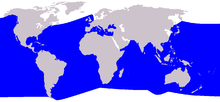Ziphius cavirostris
| Cuvier's beaked whale | |
|---|---|
 |
|
 |
|
| Size compared to an average human | |
| Scientific classification | |
| Kingdom: | Animalia |
| Phylum: | Chordata |
| Class: | Mammalia |
| Order: | Artiodactyla |
| Infraorder: | Cetacea |
| Family: | Ziphiidae |
| Genus: |
Ziphius Cuvier, 1823 |
| Species: | Z. cavirostris |
| Binomial name | |
|
Ziphius cavirostris Cuvier, 1823 |
|
 |
|
| Range of Cuvier's beaked whale | |
Cuvier's beaked whale or the goose-beaked whale (Ziphius cavirostris), the only member of the genus Ziphius, is the most widely distributed of all the beaked whales. It is one of the most frequently seen beaked whales, despite preferring deep pelagic waters, usually deeper than 1,000 m (3,300 ft).
The species name comes from Greek , "sword", and Latin , "hollow" and , "beak", referring to the indentation on the head in front of the blowhole.
The French anatomist Georges Cuvier, in his treatise Sur les Ossemens fossiles (1823), first described the species based on an imperfect skull from the Mediterranean coast of France. It had been obtained by M. Raymond Gorsse in the department of Bouches-du-Rhône, near Fos, in 1804 from a peasant who had found it on the seashore the previous year. Cuvier named it Ziphius cavirostris, the specific name being derived from the Latin cavus for "hollow" or "concave", in reference to the deep hollow (the prenarial basin) in the skull, a diagnostic trait of the species. Cuvier believed it to represent the remains of an extinct species. Zoologists did not realize the extant nature of the species until 1850, when Paul Gervais compared the type specimen to another that had stranded itself at Aresquiès, Hérault, in May of the same year, and found the two to be identical. There is no connection between Cuvier's beaked whale and the mythical Ziphius, or "Water-Owl", a creature in medieval folklore which had the characteristics of both an owl and a fish. Its dorsal fin was said to be sword-shaped, and pierced ship's hulls, while the beak was said to resemble an owl's head.
The body of Cuvier's beaked whale is robust and cigar-shaped, similar to those of other beaked whales, and can be difficult to distinguish from many of the mesoplodont whales at sea. It grows to about 5–7 m (16–23 ft) in length and weighs 2,500 kg (5,500 lb). No significant size difference is seen between sexes.
Its dorsal fin is curved, small, and located two-thirds of the body length behind the head. Its flippers are equally small and narrow and can be tucked into pockets in the body wall, presumably to prevent drag while swimming. Like other beaked whales, its flukes are large and lack the medial notch found in all other cetaceans. The head is short with a small, poorly defined rostrum and a gently sloping melon. A pair of throat grooves allows the whale to expand this region when sucking in its prey.
...
Wikipedia

